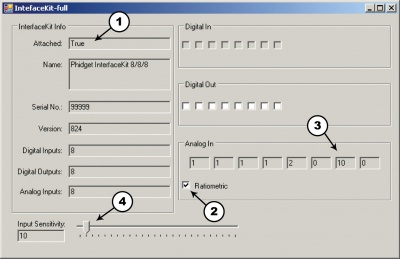1103 User Guide: Difference between revisions
| Line 65: | Line 65: | ||
The sensor will not detect objects that are more than 10cm away, but will detect objects that are closer than 10cm. When an object is in the line of sight of the sensor at a distance of 10cm or closer, the sensor value will decrease from 1000 to 0. Once the object leaves the line of sight, the value is restored to 1000. | The sensor will not detect objects that are more than 10cm away, but will detect objects that are closer than 10cm. When an object is in the line of sight of the sensor at a distance of 10cm or closer, the sensor value will decrease from 1000 to 0. Once the object leaves the line of sight, the value is restored to 1000. | ||
The IR sensor works just as well in both dim and well lit areas. | The IR sensor works just as well in both dim and well lit areas. You may have trouble using this sensor through a pane of glass, since the IR light can easily reflect off of the surface of the glass. | ||
{{UGotherint}} | {{UGotherint}} | ||
Revision as of 17:21, 1 October 2012

| |
| Go to this device's product page |
Getting Started
Checking the Contents
|
You should have received:
|
In order to test your new Phidget you will also need:
| |
Connecting the Pieces
|
| |
Testing Using Windows 2000 / XP / Vista / 7
Make sure you have the current version of the Phidget library installed on your PC. If you don't, follow these steps:
- Go to the Quick Downloads section on the Windows page
- Download and run the Phidget21 Installer (32-bit, or 64-bit, depending on your system)
- You should see the
 icon on the right hand corner of the Task Bar.
icon on the right hand corner of the Task Bar.
Running Phidgets Sample Program
Double clicking on the ![]() icon loads the Phidget Control Panel; we will use this program to ensure that your new Phidget works properly.
icon loads the Phidget Control Panel; we will use this program to ensure that your new Phidget works properly.
The source code for the InterfaceKit-full sample program can be found in the quick downloads section on the C# Language Page. If you'd like to see examples in other languages, you can visit our Languages page.
Updating Device Firmware
If an entry in this list is red, it means the firmware for that device is out of date. Double click on the entry to be given the option of updating the firmware. If you choose not to update the firmware, you can still run the example for that device after refusing.
|
Double Click on the |

| |
|

| |
|

|
Testing Using Mac OS X
- Go to the Quick Downloads section on the macOS page
- Download and run the Phidget macOS Installer
- Click on System Preferences >> Phidgets (under Other) to activate the Preference Pane
- Make sure that the Phidget InterfaceKit 8/8/8 is properly attached.
- Double Click on Phidget InterfaceKit 8/8/8 in the Phidget Preference Pane to bring up the InterfaceKit-full Sample program. This program will function in a similar way as the Windows version.
Using Linux
For a step-by-step guide on getting Phidgets running on Linux, check the Linux page.
Using Windows Mobile / CE 5.0 / CE 6.0
Technical Details
This sensor can detect the presence of an object at 10cm. This sensor does not rely on the reflective properties of the surface of the object. The sensor cannot detect the presence of the object if it is emitting large amounts of light, such as a light bulb.
The sensor will not detect objects that are more than 10cm away, but will detect objects that are closer than 10cm. When an object is in the line of sight of the sensor at a distance of 10cm or closer, the sensor value will decrease from 1000 to 0. Once the object leaves the line of sight, the value is restored to 1000.
The IR sensor works just as well in both dim and well lit areas. You may have trouble using this sensor through a pane of glass, since the IR light can easily reflect off of the surface of the glass.
Phidget Cable

The Phidget Cable is a 3-pin, 0.100 inch pitch locking connector. Pictured here is a plug with the connections labelled. The connectors are commonly available - refer to the Analog Input Primer for manufacturer part numbers.

